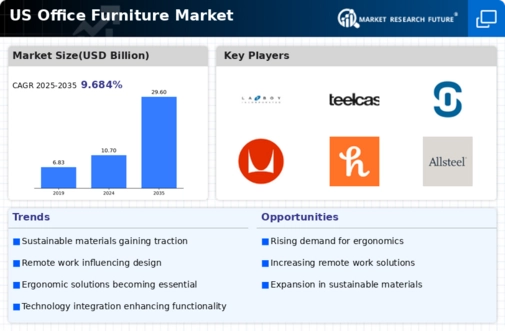The office furniture market in the US is characterized by a dynamic competitive landscape, driven by innovation, sustainability, and the increasing demand for ergonomic solutions. Major players such as Herman Miller (US), Steelcase (US), and Haworth (US) are at the forefront, each adopting distinct strategies to enhance their market positioning. Herman Miller (US) emphasizes design innovation and sustainability, focusing on eco-friendly materials and processes. Steelcase (US) leverages its extensive research capabilities to create adaptable workspaces, while Haworth (US) prioritizes global expansion and strategic partnerships to enhance its product offerings. Collectively, these strategies contribute to a competitive environment that is increasingly focused on meeting the evolving needs of modern workplaces.
Key business tactics within the office furniture market include localizing manufacturing and optimizing supply chains to enhance efficiency and responsiveness. The market structure appears moderately fragmented, with several key players exerting influence over various segments. This fragmentation allows for a diverse range of products and services, catering to different customer preferences and regional demands. The collective influence of these major companies shapes market dynamics, as they compete not only on product quality but also on service delivery and customer engagement.
In October 2025, Herman Miller (US) announced a partnership with a leading technology firm to integrate smart technology into its furniture solutions. This strategic move is likely to enhance user experience by providing customizable and interactive work environments, aligning with the growing trend of digitalization in office spaces. Such innovations may position Herman Miller (US) as a leader in the smart office furniture segment, potentially attracting tech-savvy clients seeking modern solutions.
In September 2025, Steelcase (US) launched a new line of sustainable office furniture made from recycled materials. This initiative not only reflects the company's commitment to environmental responsibility but also addresses the increasing consumer demand for sustainable products. By prioritizing sustainability, Steelcase (US) may strengthen its brand loyalty and appeal to environmentally conscious businesses, thereby enhancing its competitive edge in the market.
In August 2025, Haworth (US) expanded its manufacturing capabilities in Mexico, aiming to reduce lead times and improve supply chain efficiency. This strategic expansion is indicative of a broader trend among manufacturers to localize production in response to fluctuating global supply chains. By enhancing its operational efficiency, Haworth (US) could potentially offer more competitive pricing and faster delivery times, which are critical factors for clients in the current market.
As of November 2025, current competitive trends in the office furniture market include a pronounced focus on digitalization, sustainability, and the integration of artificial intelligence (AI) into product offerings. Strategic alliances are increasingly shaping the landscape, enabling companies to leverage complementary strengths and enhance their market presence. Looking ahead, competitive differentiation is likely to evolve from traditional price-based competition to a focus on innovation, technology integration, and supply chain reliability. This shift suggests that companies that prioritize these aspects may gain a significant advantage in an increasingly competitive market.

























Leave a Comment